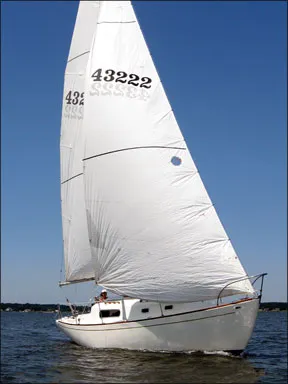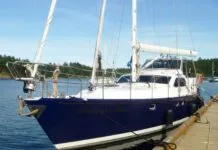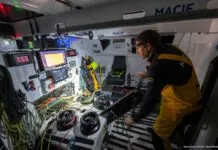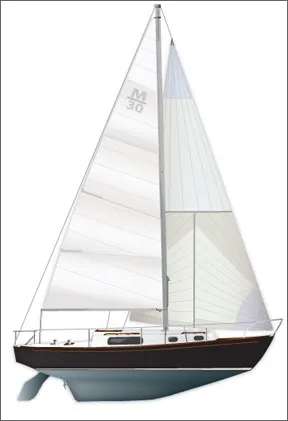If youre looking for an inexpensive 30-footer from the 1970s with pretty lines that can double nicely as either the family escape pod or a Wednesday-night racer, the list of choices is long. In the February 2008 issue of Practical Sailor, we looked at nine 30-footers from the 70s: the C&C 30, Cal 2-30, Hunter 30, Irwin Competition 30, Newport 30, 0Day 30, Pearson 30, Tartan 30, and the Catalina 30. Three climbed to the top of Practical Sailors short list: The Pearson 30 was noted for its performance; the Tartan 30 for its Sparkman & Stephens pedigree; and the Catalina for its avid fan base.
All of the classics featured in that article were fixed fin-keel boats that drew just under 5 feet of water, although a few, like the Hunter and the Catalina, offered versions with less than 4.5-feet draft.

The advantages and compromises of a shoal-draft race-cruiser bring us to this months featured boat, the Morgan 30. The design predates most of the boats highlighted in our 2008 article and features a shallow, nearly full keel with a swinging centerboard that reduces draft to 3-feet, 6-inches, permitting access to some prime gunkholing waters on the Gulf and Atlantic coasts.
DESIGN
The Morgan 30 was introduced in 1967, when Charley Morgan and Morgan Yachts were still riding the wave of success following Paper Tiger and Sabre, the legendary Southern Ocean Racing Conference (SORC) racers of the early 1960s that helped launched Morgans career as a production boatbuilder.
At that time, racing was an essential part of the equation at Morgan Yachts-based in Largo, Fla.-so the rig and underbody were guided by the dominant rating rule. After the 1970 launch of the Morgan Out Island 41, the builder became more closely identified with the roomy Out Island series, the pure cruising line that played a key role in the emerging Caribbean charter trade.
Two driving forces lie behind the design of the Morgan 30. The first, and most influential, is the Cruising Club of America (CCA) rating system, which, because it made allowances for livability, generated some pretty, sea-kindly boats that easily made the transition from SORC racer to long-distance cruiser.
Morgan proved very adept at working within this rule. While none of Morgans production racer-cruisers like the 30 pushed the CCA envelope to a great degree, they incorporated several signature features that worked well in Morgans early custom designs. Ultimately, Morgans racer-cruiser archetype was a boat with V-sections forward, conservative beam, long overhangs at the bow and stern (to extend the sailing waterline beyond the measured length when heeled), internal ballast, a swing keel, and a relatively low-aspect sailplan featuring a big, overlapping genoa.
On the water, the Morgan 30 is a fine boat to look at, with springy sheer and an attractive stern. Although the boat has a full 6-foot, 2-inch headroom, the freeboard is low. This graceful form predates World War II and can be found in late CCA-era boats from Al Mason, Phillip Rhodes, and Ted Hood, designers who also excelled at maximizing performance under the rule and maintaining an aesthetic appeal.
Construction
The Morgan 30 shared many of the construction details of the 34, its predecessor, which is reviewed in depth in our “Practical Boat Buying Guide” ($39, www.practical-sailor.com/
products/books/). The Morgan 34 review can also be purchased online at
www.practical-sailor.com.
More than 300 Morgan 30s were built, and the construction methods evolved over the years, so what follows is a general description.
The hull was hand-laid woven roven and mat cloth with polyester resin. The layup schedule was on par with production models of that era-lighter than some, heavier than others. Blisters have been documented in many Morgan hulls, but the earlier models seem less prone. These reportedly also have thicker layup schedules. The deck was through-bolted to an inward-turning flange on the hull, with a bedding compound used to seal the joint. This is a common source of leaks on older boats.
Early boats were stick built, with floors and furnishings bonded in place individually, but later boats incorporated molded fiberglass pan-liners in the bow and main cabin to expedite production. Some owner-finished kit boats, sold as bare hulls, are likely to be floating around as well.
The deck was cored with plywood on some boats, balsa on others, and sometimes both cores were used to suit the location and loads. Encapsulated ballast is used in the keel. About 500 pounds extra was added after the first few hulls.
The jacknife centerboard is fiberglass and neatly seats into the keel without intruding into the cabin space. (Morgan based his design on one he admired in Wirth Munroes famous Comanche, now owned by Wirths son, Charles.)
DECK DETAILS AND SYSTEMS
The standard Morgan 30 is tiller-steered, an arrangement Practical Sailor generally prefers in boats of this size for its adaptability to cheap self-steering (see “Tillerpilot Sea Trials,” June 2009) and its responsiveness. Although the tiller consumes cockpit space, the area is roomy enough for four adults to sail comfortably.
Low coamings surround the cockpit, helping to keep it dry. The cockpit drains, however, are small, and anyone serious about taking this boat offshore should increase their diameter to 2 inches. Only a low sill protects the companionway; a raised bridgedeck is preferred for offshore work. Cockpit stowage is limited to a lazarette. Some ambitious Morgan owners add a bench-seat locker in lieu of one of the quarter berths below.
The volatile metal prices of the Vietnam War era forced Morgan and most builders of that period to cut back on premium metals like bronze and monel. Nevertheless, some of the chrome-plated bronze hardware on earlier Morgan 30s has withstood the test of time. One metal component that often raises the concerns of riggers is the cast- aluminum stemhead fitting at the bow, but weve heard of no widespread reports of cracking or failures.

Virtually every bit of sailing hardware was optional, so youll see a wide range of gear. In the typical running rigging layout, the mainsheet leads through a multi-purchase block on the boom end, where the load belongs. The traveler stretches behind the tiller. The jib sheets lead through blocks on rail-mounted tracks. Primary and secondary winches are mounted on the coamings. Tiller steering generally places the helmsman out of easy reach of the mainsheet. Wheel steering brings all the sail control lines closer at hand.
The mast is a slightly tapered, deck-stepped, single spreader rig. The boom is a heavy extrusion that was designed to spin on bearings in a forgettable iteration of roller-reefing. Morgan strongly suggests going back to good old slab reefing and a lazy-jack or Dutchman system (“Taming the Main,” PS February 2008.)
The sidedecks are wide for a boat of this beam. Grab rails on the cabin top and a low teak toe-rail provide a measure of security going forward. The shrouds lead outboard, so there is no tight squeeze impeding quick movement fore and aft.
The foredeck, as that of most racer-cruisers, is relatively clear of trip hazards, but also short on ground tackle arrangements. Due to the cast stemhead, adding a bow roller or even roller furling may require a little ingenuity. The chain and rode lead below decks through a hawse pipe, typical of boats of this period.
Systems are extremely basic on the Morgan 30, which came standard with one battery and a simple 12-volt DC panel for navigation lights and seven interior lights. Propulsion was gasoline, either a Palmer M60 on older boats, or a Universal Atomic Four. In either case, the buyer should assume that an original engine is probably due for replacement, a significant investment.
The standard tankage called for a 58-gallon water tank and a 14-gallon fuel tank, adequate for most coastal cruising needs. Pumps for the sinks in the galley and head were manual.
INTERIOR
The CCA-era overhangs yield an interior space that is markedly smaller than 30-footers of today. On paper the boat sleeps seven, but four is about the limit for those who hope to remain on speaking terms.
The standard layout, featuring a galley running fore and aft on the starboard side and a dinette to port, works fine at the dock, but at sea on a reach either the cook or the diners will be on the windward side cursing their misfortune as they try to stay in one place. On modern boats, a U-shaped galley and settees on each side add civility to mealtime underway.
The forward V-berth, head (to port), and hanging locker (to starboard) are separated from the main cabin by a pocket door. The door seems like a good idea until it gets wet, swells and jams, something that is likely since it is located beneath the mast partners. The V-berth and quarterberths are snug, and the drop-down dinette berth is a bit tight for tall folks.
There is no navigation station, so if you like electronics, plan to improvise. Several owners have done fine with swing-out plotter-sounders (see “Petite Plotter Sounders,” October 2008) that can be viewed from below, where the galley countertop serves as a chart table, or from the cockpit.
For short family cruises, coastal sailing, and Wednesday night racing, the interior is perfectly functional, though less than ideal.
PERFORMANCE
In terms of performance, Morgan 30 owners are in unanimous agreement on a few points. It is not the fastest boat around the cans, nor the most maneuverable under power, but its extremely well balanced and presents an easy motion in a seaway.
“This boat is great on a reach!” summed up one owner who responded to our survey.
For a benchmark rating for the Performance Handicap Racing Fleet (PHRF) we turned to the 2008 North Carolina PHRF fleet, which gave the Morgan 30 a 195 handicap, slightly behind ratings for the Catalina 30 (186), and well behind the numbers for the Tartan 30 (174) and Pearson 30 (177), all more modern, lighter boats with less wetted surface.
Our sea trials aboard reader Ray Mummerys Morgan 30 Wavedancer in South Floridas Biscayne Bay, offered proof of the boats impeccable balance. In 12 knots of breeze, with a 130-percent genoa, Wavedancer easily steered herself to windward, even holding a course as deep as 120-degrees relative wind angle, with no attention to the helm. In modest gusts, the boat didnt miss a beat, picking up a half-knot with little or no weather helm. The ability to tweak the centerboard added one more tool for balancing the helm.
Compared to modern 30-footers with canoe underbodies and fin keels, the boat is far from nimble. Backing the boat under power requires due diligence and the boat is not quick to accelerate under sail. What the boat lacks in thrills, she makes up for with a seakindly ride. Wavedancer maintained headway in a chop with little complaint, punching though some steep wake generated by passing yacht traffic. The boats V-section shouldered aside the biggest waves, although it was obvious that the low freeboard and short waterline length would make for a wet cockpit in rough going. All in all, the boat delivers a very rewarding ride. Neither sluggish, nor sprightly, her behavior could best be described as confident.
CONCLUSION
A Morgan 30 that has been repowered and is in good condition can be found for about $15,000. A new production 30-footer runs about $100,000. While the Morgan might seem like a bargain, this is a very old boat, prone to problems that could easily set you back $30,000 or more and a big chapter of your life. If a qualified professional surveyor finds your prospective Morgan 30 free of serious problems, and it has some, if not all of our recommended upgrades, then it is worth a look, It will be particularly appealing for sailors who enjoy a “character” boat that can squeak into shallow water. On the other hand, if it has been sitting neglected for years, prepare for a long haul.
Blisters, broken centerboards, leaky ports, and corroding mast steps are just some of the problems Steve Cocklin faced during the ongoing restoration of his Morgan 30 documented online at www.myholeinthewater.com.




































I have a Morgan 30, 1971, with two large port lights in the main cabin rather than one. I’ve seen this design only on my boat. I wondered if perhaps she was a mislabeled Morgan 30-2. She has a center board and fits the 30 characteristics. Any input is welcome. How does one get in touch with Charlie Morgan?
Bill, I have acquired a 1972 22ft Morgan Sailboat.. The mast was down and in a cradle when I picked it up.
All of the rigging appears to be in good shape. I am hunting for a manual or guide to setting the mast and rigging.
I don’t want to mess something up. I am 85 years old and have learned to ask for help.
Thank You
Larry R. Witt
Larry, did you find what you needed? I have an original manual with all the specks I’ve needed. I’ll share it with you in photo copy form. By the way, I’m 74. Bill Lamp
Larry I own a Morgan 22 1970. Did you find what you need? I have a lot of data. Call me if you like 317 679 4970
SteveB